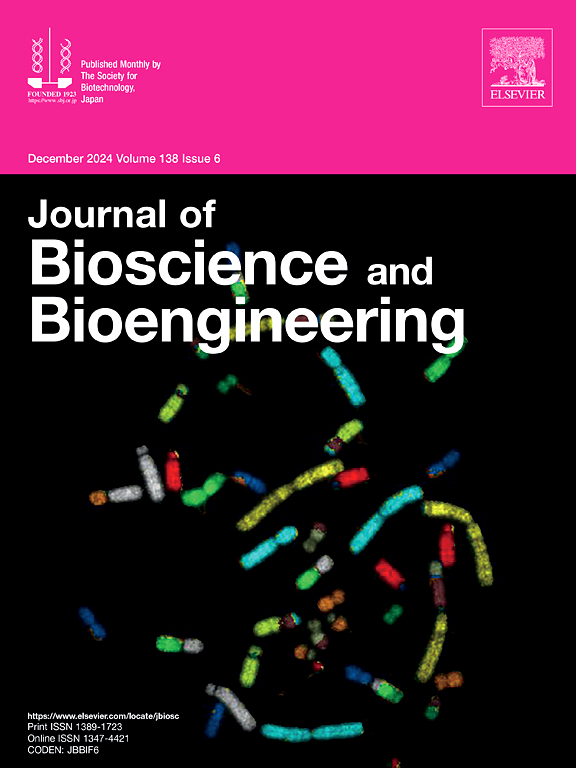Combinational manipulation of transcription factors, CreA and ClbR, is a viable strategy to improve cellulolytic enzyme production in Aspergillus aculeatus
IF 2.3
4区 生物学
Q3 BIOTECHNOLOGY & APPLIED MICROBIOLOGY
引用次数: 0
Abstract
The production of cellulolytic enzymes in response to inducible carbon sources is mainly regulated at the transcriptional level in filamentous fungi. We have identified a cellobiose-response regulator (ClbR) controlling the expression of cellulolytic enzyme-encoding genes in Aspergillus aculeatus. However, the engineering potential of combining the deletion of transcriptional repressors with the overexpression of transcriptional activators to enhance enzyme production has not been analyzed. Here, we investigated the effect of the deletion of the transcriptional repressor creA and the overexpression of the transcriptional activator clbR in enzyme production in A. aculeatus. Here, we verified that a combination of creA deletion and clbR overexpression (Δc&OE) improved cellulase, β-1,4-xylanase, and β-glucosidase production. Cellulase and β-1,4-xylanase production increased 3.4- and 8.0-fold in Δc&OE compared with the host strain (MR12) at 96-h incubation, respectively. β-Glucosidase production in ΔcreA and Δc&OE increased approximately 5.0-fold compared with that in MR12 at 240-h incubation. Transcriptional analysis revealed that the increase in enzyme production was due to increased expression of cellobiohydrolase, endo-β-1,4-glucanase, β-1,4-xylanase, and β-glucosidase 1 (bgl1). Interestingly, bgl1 expression in ΔcreA increased in a dose-dependent manner in response to glucose. Thus, combinational manipulation of transcription factors improved cellulase, xylanase, and β-glucosidase production in A. aculeatus.
联合操纵转录因子 CreA 和 ClbR 是提高黑曲霉纤维素分解酶产量的可行策略。
在丝状真菌中,针对诱导性碳源产生纤维素分解酶主要是在转录水平上进行调控的。我们已经发现了一种控制黑曲霉中纤维素分解酶编码基因表达的纤维生物糖反应调节因子(ClbR)。然而,将转录抑制因子的删除与转录激活因子的过度表达相结合以提高酶产量的工程潜力尚未得到分析。在此,我们研究了转录抑制因子 creA 的缺失和转录激活因子 clbR 的过表达对 A. aculeatus 产酶的影响。在这里,我们验证了creA缺失和clbR过表达(Δc&OE)的组合提高了纤维素酶、β-1,4-木聚糖酶和β-葡萄糖苷酶的产量。与宿主菌株(MR12)相比,培养 96 小时后,Δc&OE 的纤维素酶和 β-1,4-木聚糖酶产量分别增加了 3.4 倍和 8.0 倍。在 240 小时的培养过程中,ΔcreA 和 Δc&OE 的 β-葡萄糖苷酶产量比 MR12 增加了约 5.0 倍。转录分析表明,酶产量的增加是由于纤维生物水解酶、内-β-1,4-葡聚糖酶、β-1,4-木聚糖酶和β-葡萄糖苷酶 1(bgl1)表达的增加。有趣的是,ΔcreA 中 bgl1 的表达在葡萄糖作用下呈剂量依赖性增加。因此,对转录因子进行组合操作可提高钝顶水蚤的纤维素酶、木聚糖酶和β-葡萄糖苷酶产量。
本文章由计算机程序翻译,如有差异,请以英文原文为准。
求助全文
约1分钟内获得全文
求助全文
来源期刊

Journal of bioscience and bioengineering
生物-生物工程与应用微生物
CiteScore
5.90
自引率
3.60%
发文量
144
审稿时长
51 days
期刊介绍:
The Journal of Bioscience and Bioengineering is a research journal publishing original full-length research papers, reviews, and Letters to the Editor. The Journal is devoted to the advancement and dissemination of knowledge concerning fermentation technology, biochemical engineering, food technology and microbiology.
 求助内容:
求助内容: 应助结果提醒方式:
应助结果提醒方式:


